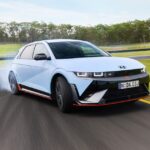Dodge is set to expand its iconic muscle car legacy across the Atlantic, as the automaker prepares to introduce the next-generation Dodge Charger to European and Middle Eastern markets by late 2025. This rollout will encompass a diverse lineup featuring both internal combustion engine (ICE) and electric vehicle (EV) options, available in both two-door and four-door configurations.
As Dodge undergoes a transformative phase, the American automotive giant is redefining its brand for the contemporary consumer. In North America, the Charger Daytona EV has sparked a mix of enthusiasm and skepticism, boasting an impressive output of up to 630 horsepower with its dual-motor design. Yet, for fans of traditional performance, Dodge continues to embrace its roots by offering the Hurricane inline-six engine, available in two variants: a standard output of 420 horsepower and a high-output version delivering 550 horsepower.
### Dodge Maintains Its Internal Combustion Legacy
The Charger Daytona, its electric iteration, will be the first model to hit international shores. When equipped with the dual-motor system, the flagship Daytona Scat Pack impresses with a blistering acceleration time of just 3.3 seconds from 0 to 60 mph.
Dodge’s initial focus on the Daytona emphasizes its dedication to the future of electrification, though this shift has not been without its detractors. Traditionalists were further disheartened by reports from MotorTrend indicating that the Charger Daytona lacks a line lock feature, rendering it incapable of performing a burnout—a rite of passage for many muscle car enthusiasts.
For aficionados who still yearn for the roar of a gasoline engine, Dodge will provide ICE models powered by the 3.0-liter Hurricane inline-six. Both two-door and four-door variants will utilize an updated eight-speed automatic transmission; however, the absence of a manual option marks a notable departure from Dodge’s heritage of legendary manual muscle.
### A Strategic International Venture
Dodge’s expansion into European and Middle Eastern markets represents a significant strategic initiative from Stellantis, its parent company. While the Charger has long surged within American culture, its combination of commanding performance and usability may captivate a new audience abroad. Nevertheless, this timing presents challenges—traditional muscle car enthusiasts are dwindling, and increasingly stringent emissions regulations loom large on the global horizon.
The intention to export the Charger aligns with Dodge’s recent move to discount the Charger Daytona in the U.S. market, underscoring a keen desire to reach a wider demographic. Though the muscle car market remains a niche segment in Europe and the Middle East, the dual offering of both ICE and EV configurations could differentiate Dodge in a competitive landscape.
### Conclusion
The future success of the Charger in these new territories is yet to be determined. Nonetheless, Dodge’s bold initiative signals an aspiration to establish itself as a formidable player on the global stage, extending the allure of American muscle cars beyond the confines of the U.S. market. If the EV variants of the Charger encounter hurdles in the U.S., there remains hope that European consumers—who have exhibited stronger support for EVs—may embrace them with open arms.
Source:www.autoblog.com






